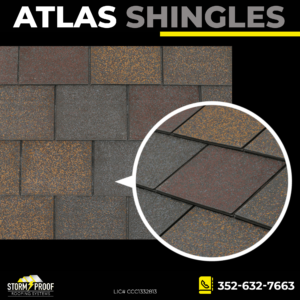Table of Contents
Introduction
Welcome to Storm Proof Roofing Systems, your go-to source for all things roofing. With years of expertise and a commitment to quality, we understand the importance of a reliable roof over your head. In this comprehensive guide, we’ll answer the most common roofing questions, providing insights and tips to ensure your roof stays in top condition. Let’s dive into the world of roofing!
What is the Lifespan of a Typical Roof?
The lifespan of a roof varies depending on materials and climate. Asphalt shingles, popular in Inverness, Florida, typically last 20-30 years, while metal roofs in Citrus County, Florida, can last over 50 years. Regular maintenance and inspections are key to maximizing your roof’s lifespan.
How Often Should I Have My Roof Inspected?
Routine inspections are crucial. It’s recommended to have your roof inspected annually, especially after severe weather events. Regular checks can identify potential issues early, preventing costly repairs down the line.
Signs Your Roof Needs Replacing
Look out for:
- Missing or damaged shingles
- Sagging roof deck
- Water damage inside your home
- Algae or moss growth
These signs indicate it’s time for a roof replacement.
Can I Install a New Roof Over My Existing One?
While it’s possible to install a new roof over an existing one, it’s not always advisable. It can mask underlying issues and add extra weight to your home’s structure. Consult with a professional at Storm Proof Roofing Systems for the best approach.
Choosing the Best Roofing Material
The best roofing material depends on your climate, budget, and aesthetic preferences. Popular options include:
- Asphalt shingles (Atlas Shingles)
- Metal roofing (Benefits of Metal Roofing)
- Clay or concrete tiles (Tile Roofing in Port Charlotte)
Consider factors like durability, maintenance, and energy efficiency.
Cost of a New Roof
The cost varies based on size, material, and labor. On average, homeowners spend between $5,000 to $10,000. For a detailed roof estimate, contact Storm Proof Roofing Systems.
Time Required to Install a New Roof
Installation time varies. A small, uncomplicated roof might take a few days, while larger or more complex roofs could take a week or more. Weather conditions also play a role.
Shingles vs. Tiles: What’s the Difference?
- Shingles: Typically made of asphalt; affordable, versatile, and easy to install. Great for varying weather conditions.
- Tiles: Made of clay or concrete; more durable but heavier and more expensive. Ideal for homes with strong structural support.
Explore more about these materials at Shingle Replacement in Citrus County, Florida and Tile Roofing in Port Charlotte.
DIY Roofing Repairs: Should You Attempt Them?
DIY repairs can be risky and may not provide a lasting solution. It’s safer and more effective to rely on professional roof repairs.
What is Roofing Underlayment?
Roofing underlayment is a waterproof or water-resistant barrier placed under shingles or tiles. It provides an extra layer of protection against moisture and weather damage. For high-quality options, consider Summit 60 Synthetic Underlayment.
Benefits of Metal Roofing
Metal roofing offers:
- Longevity
- Durability
- Energy efficiency
- A wide range of styles and colors
Learn more about metal roofing in Citrus County here.
Choosing a Reliable Roofing Contractor
When selecting a contractor, consider:
- Licensing and insurance
- Experience and reputation
- Local references and reviews
- Written estimates and contracts
For trusted services in Ocala, check out Roofing Contractor in Ocala, FL.
Understanding Roofing Warranties
Roofing warranties cover material defects and workmanship errors. They vary by manufacturer and contractor, so it’s important to understand the terms and coverage. Storm Proof Roofing Systems offers comprehensive warranties for peace of mind.
Maintaining Your Roof
Regular maintenance includes:
- Cleaning gutters
- Removing debris
- Inspecting for damage
- Addressing minor repairs promptly
For more tips, visit our maintenance guide.
Weather Impact on Roofs
Weather conditions like hail, wind, and extreme temperatures can affect your roof’s integrity. Regular inspections, especially after storms, can mitigate these effects.
Types of Roofing Nails and Their Uses
- Galvanized nails: Rust-resistant, ideal for asphalt shingles
- Aluminum nails: Best for metal roofs
- Copper nails: Used for slate and tile roofs
Each type serves a specific purpose, ensuring optimal roof performance.
Are Roofing Companies Profitable?
Yes, roofing companies can be quite profitable. The demand for quality roofing services remains high, especially in areas prone to severe weather. Storm Proof Roofing Systems prides itself on offering top-notch services while maintaining profitability.
The Safety of Roofing Tar Fumes
Roofing tar fumes can be harmful if inhaled in large quantities over time. It’s important to ensure proper ventilation and use safety equipment during application.
The Legality of Roofing Contracts
Roofing contracts are legally binding agreements outlining the scope of work, costs, and responsibilities. It’s crucial to review and understand these contracts before signing.
Transferability of Roofing Warranties
Some roofing warranties are transferable to new homeowners, adding value to your property. Check the specific terms of your warranty for details.
The Availability of Free Roofing Estimates
Many roofing companies, including Storm Proof Roofing Systems, offer free estimates to assess the condition of your roof and provide a cost outline. Contact us at 352-268-1990 or visit Roof Estimate in Crystal River for more information.
Dealing with Wet Roofing Materials
While some roofing materials can withstand moisture, it’s generally best to avoid installing a roof in wet conditions. Wet materials can compromise the integrity of the roof and lead to future problems.
Painting Roofing Shingles
While it’s possible to paint roofing shingles, it’s not always recommended as it can affect their functionality and warranty. If considering this, consult a professional for advice.
The Purpose of Roofing Felt
Roofing felt provides an extra layer of protection against moisture, acting as a barrier between the roof deck and the shingles. It also helps shingles lay flat and uniform.
Different Roofing Systems
Roofing systems vary from traditional asphalt shingles to modern solar roofs. Each type offers unique benefits and suits different needs and preferences. Explore options like GAF Timberline UHDZ Shingles and Metal Roofing Installation.
Different Types of Roofing Systems
There are several types of roofing systems, each suited for different needs:
- Asphalt Shingles: Widely used due to affordability and ease of installation. Check Atlas Shingles for quality options.
- Metal Roofs: Known for durability and energy efficiency (Metal Roofing Citrus County).
- Tile Roofs: Offer a unique aesthetic and longevity (Tile Roofing Port Charlotte).
- Flat Roofs: Common in commercial buildings, they are easier to access but require more maintenance.
- Green Roofs: Incorporate vegetation, improving insulation and reducing urban heat islands.
- Solar Roofs: Feature solar panels or tiles, generating electricity while protecting your home.
Identifying Storm Damage on Your Roof
Storm damage can manifest as missing shingles, dents on metal roofs, or leaks. After a storm, inspect your roof or schedule a professional inspection to assess any damage.
Actions for a Leaking Roof
If your roof is leaking, place a bucket under the leak, move any valuables away, and contact Storm Proof Roofing Systems for urgent repairs. Delaying repairs can lead to more significant damage.
Preventing Algae and Moss Growth
To prevent algae and moss:
- Ensure proper roof ventilation
- Keep gutters clean
- Trim overhanging branches
- Consider anti-algae treatments or algae-resistant shingles
Pros and Cons of Flat Roofing
Pros:
- More accessible and easier to inspect
- Space for HVAC units or green roofing
Cons:
- Prone to water pooling and leaks
- Higher maintenance needs
The Role of Attic Ventilation in Roof Health
Proper attic ventilation regulates temperature and moisture levels, preventing issues like ice dams, mold growth, and shingle degradation. Learn more about ventilation solutions at Roof Ridge Vent.
Energy-Efficient Roof Colors
Lighter roof colors reflect sunlight, reducing heat absorption and energy costs. For a range of colors, visit Shingle Colors.
Cleaning Your Roof
To clean your roof:
- Use a gentle, non-corrosive cleaner
- Avoid high-pressure washers
- Consider hiring professionals for safety and efficiency
Understanding Green Roofs
Green roofs are covered with vegetation, improving insulation, reducing urban heat, and promoting biodiversity. They require a robust waterproofing system and maintenance.
Solar Roofs Explained
Solar roofs integrate solar technology into shingles or tiles. They generate electricity, reduce energy bills, and can be aesthetically pleasing. Learn about solar options at Solar Roofs.
Residential vs. Commercial Roofing
Residential roofing typically involves shingles and steeper slopes, focusing on aesthetics and weather resistance. Commercial roofing often uses materials like modified bitumen or TPO, prioritizing durability and maintenance.
Preparing Your Roof for Hurricane Season
To prepare for hurricanes:
- Inspect and repair your roof regularly
- Trim trees near your home
- Secure loose shingles
- Consider installing hurricane straps
The Importance of Roof Flashing
Flashing is a material used to direct water away from critical areas of the roof, such as chimneys and valleys, preventing leaks. Its proper installation and maintenance are crucial.
Signs of a Failing Roof
A failing roof may show:
- Frequent leaks
- Cracked, curled, or missing shingles
- Sagging roof deck
- Excessive granule loss from shingles
Avoiding Roofing Scams
To avoid scams:
- Seek licensed and insured contractors (Roofing Company Crystal River)
- Get multiple quotes
- Avoid contractors who demand full payment upfront
The Roof Replacement Process
The process involves:
- Removing old shingles
- Inspecting and repairing the deck
- Installing new underlayment and shingles
- Final inspection
Choosing the Right Roofing Color
Consider your home’s style, climate, and local regulations. Light colors are energy-efficient, while dark colors suit colder climates. Browse Rich Color Palette for ideas.
Understanding Roof Pitch
Roof pitch, the angle of your roof, affects drainage and aesthetic appeal. Different materials work best at specific pitches. A steep pitch might require more materials and labor.
Benefits of a Cool Roof
Cool roofs reflect more sunlight and absorb less heat, reducing energy bills and improving indoor comfort.
Roof’s Impact on Home Insurance
Your roof’s condition can influence insurance premiums and coverage. A well-maintained roof may lead to lower premiums.
Roofer vs. Roofing Contractor
A roofer typically performs the physical labor of roofing, while a roofing contractor manages the overall project, including materials, labor, and compliance with legal requirements.
Dangers of DIY Roofing
DIY roofing can lead to improper installation, injuries, and voided warranties. It’s safer to rely on professionals like Storm Proof Roofing Systems.
Roof Certification Explained
A roof certification, usually required during real estate transactions, is an inspection that certifies the roof’s condition and estimates its remaining lifespan.
Filing a Roofing Insurance Claim
To file a claim, document the damage, review your policy, and contact your insurance company promptly. For assistance, see Insurance Claims Assistance.
What is Roof Decking?
Roof decking is the foundation layer of the roof onto which everything else is placed. It needs to be strong and resilient.
Benefits of Seamless Gutters
Seamless gutters have fewer leaks, require less maintenance, and offer a sleek look. They are custom-made to fit your home’s specifications.
3-Tab Shingles vs. Architectural Shingles
- 3-Tab Shingles: Flat and uniform, these shingles are budget-friendly and offer a traditional look. Their lifespan is typically shorter.
- Architectural Shingles: Thicker and more durable, they provide a multi-dimensional appearance and better withstand environmental factors. Explore options like GAF Timberline HDZ Shingle Colors.
Benefits of Gutter Guards
Gutter guards prevent debris accumulation, reduce cleaning frequency, and prevent water damage by ensuring smooth water flow.
Understanding Roof Ridge Vents
A roof ridge vent runs along the peak of the roof, allowing hot, moist air to escape from the attic, promoting effective ventilation.
The Purpose of Roof Soffits
Soffits cover the underside of roof overhangs, providing ventilation to the attic and protecting rafters from weather elements.
Signs of Poor Attic Ventilation
Indicators include:
- Overheated attic space
- Moisture or mold growth
- Ice dams in winter
- Premature aging of roofing materials
Hip Roof vs. Gable Roof
- Hip Roof: Slopes on all four sides, offering stability and wind resistance.
- Gable Roof: Has two sloping sides that form a triangle at the end of a building, known for its simple design and effective shedding of water.
What is a Roof Valley?
A roof valley is where two roof planes intersect, forming a V-shaped depression. It’s crucial to ensure proper sealing in these areas to prevent leaks.
The Role of Drip Edges
Drip edges are metal flashings placed at the edges of a roof. They direct water away from the fascia and protect underlying roofing components.
Preventing Ice Dams
Ice dams occur when snow melts and refreezes at the roof’s edge. To prevent them:
- Ensure proper attic insulation and ventilation
- Remove snow from the roof after heavy storms
- Consider installing heating cables
Understanding Roof Crickets
A roof cricket is a small, ridged structure designed to divert water around high-risk areas like chimneys, preventing pooling and leaks.
The Function of Roof Dormers
Dormers are windowed structures projecting from a sloping roof, providing natural light, ventilation, and space to attics.
Roof Eaves Explained
Eaves are the overhanging edges of a roof that extend beyond the walls, protecting the siding and foundation from water runoff.
What is Roof Fascia?
The fascia is a horizontal board running along the edge of the eaves, to which gutters are commonly attached. It’s also an aesthetic element of the home’s exterior.
Roof Trusses and Their Importance
Roof trusses are the structural frameworks that support the roof’s weight. They are crucial for maintaining the roof’s shape and integrity.
Roof Joists: A Key Structural Component
Roof joists are horizontal beams that provide support for the roof deck and shingles. They play a vital role in roof structure.
The Significance of a Roof Ridge
The roof ridge is the highest point of a sloped roof, running its entire length and providing a spot for ridge vents.
Understanding Roof Rafters
Rafters are sloping beams that extend from the ridge or hip to the wall plate. They form the primary support structure for the roof covering.
Roof Sheathing: The Foundation Layer
Roof sheathing, usually plywood or OSB, is the layer of panels covering the rafters, providing a base for the roofing material.
What is a Roof Vent Pipe?
A roof vent pipe, or stack vent, allows gases from plumbing systems to escape, preventing pressure buildup and odor intrusion.
Roof Lanterns: Adding Natural Light
Roof lanterns are raised, glass-structured elements on a roof that allow for more natural light and architectural interest.
The Role of a Roof Parapet
A roof parapet is a low wall or railing along the edge of a roof, balcony, or terrace, providing safety and architectural character.
What is a Roof Terrace?
A roof terrace is an outdoor living space built on the roof, offering a unique area for relaxation and entertainment.
Roof Verge: The Roof’s Edge
The roof verge refers to the edges of the roof where the tiles end, typically finished with pointing or dry verge systems for a neat appearance.
Roof Finials: A Decorative Touch
Roof finials are decorative features, often placed at the peak of roofs or turrets, adding an elegant finish to the building.
Understanding Roof Gables
A roof gable is the triangular portion of a wall between the edges of a dual-pitched roof. It’s a common design element in traditional architecture.
The Function of Roof Purlins
Roof purlins are horizontal beams laid across trusses to support the roof deck, tiles, or metal roofing panels.
Roof Louvres for Ventilation
Roof louvres are slatted openings, often incorporated into the design of a roof, to provide ventilation while keeping out rain and debris.
The Architectural Beauty of Roof Monitors
Roof monitors, similar to dormers, are raised structures on a roof with windows. They enhance natural light and ventilation.
What is a Roof Cornice?
A roof cornice is the decorative molding along the top of a building’s wall, adding architectural detail and assisting with rainwater diversion.
The Elegance of Roof Cupolas
A roof cupola is a small, dome-like feature on top of a roof, often used for ventilation or purely as an architectural ornament.
Roof Balustrades for Safety and Style
A roof balustrade is a row of small columns topped by a rail, used as a decorative feature or as a safety barrier on roof terraces.
Understanding Roof Bargeboards
Bargeboards are decorative boards covering roof timbers or the ends of gable roofs, adding aesthetic appeal to the home’s exterior.
The Function of Roof Corbels
Roof corbels are projecting brackets or blocks supporting a structure above, often used decoratively under eaves or in gable ends.
The Architectural Detail of Roof Pediments
Roof pediments are triangular, classical decorative elements at the front of buildings, particularly above windows and doors.
Roof Quoins: Cornerstones of Design
Roof quoins are decorative stones or bricks at the corners of buildings, enhancing the aesthetic and perceived strength of the structure.
What is a Roof Soffit?
A roof soffit is the underside of the roof’s overhang, which can contain vents for attic ventilation and contributes to the overall aesthetics of the house.
The Grandeur of Roof Spires
Roof spires are tall, pointed elements at the top of a building, often seen in historical and religious architecture for a dramatic effect.
Roof Turrets: Adding Vertical Interest
A roof turret is a small tower at the corner or middle of a roof, often functional for staircases or as a lookout point.
Roof Valley: Managing Water Flow
A roof valley is the internal angle formed by the intersection of two roof slopes, which must be sealed properly to manage water runoff efficiently.
Understanding Roof Watersheds
A roof watershed is an area of a roof from which water is directed to gutters and downspouts, ensuring proper water management.
The Charm of a Roof Widow’s Walk
A widow’s walk is a railed rooftop platform, often found in coastal homes, historically used for viewing the sea.





